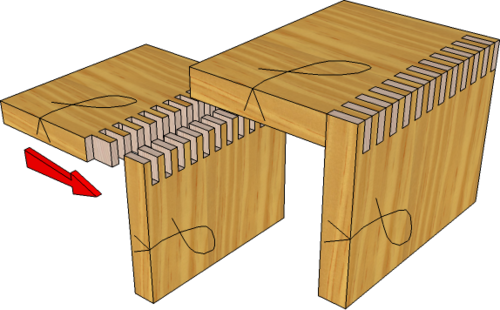Comb Joint: Difference between revisions
From DT Online
(Created article) |
m (Corrected Link) |
||
| Line 6: | Line 6: | ||
Variations of a '''Comb Joint''' are used as '''[[Widening Joint|Widening Joints]]''' and '''[[Scarf Joint|Scarf]]''' or '''[[Lengthening | Variations of a '''Comb Joint''' are used as '''[[Widening Joint|Widening Joints]]''' and '''[[Scarf Joint|Scarf]]''' or '''[[Scarf Joint|Lengthening Joints]]'''. For these applications the '''''Fingers''''' are often tapered and the joint cut with a '''[[Router]]''' fitted with a '''Finger Joint Router Bit'''. | ||
[[File:FingerJoints.png|750px|center]] | [[File:FingerJoints.png|750px|center]] | ||
Latest revision as of 18:08, 21 February 2016
A Comb Joint (aka 'Finger Joint' or 'Box Joint') consists of a series of alternate notches and square pins of the same width which interlock when the joint is assembled.
Comb Joints can be cut by hand in much the same way as a Dovetail Joint but are more quickly and easily cut using a Router fitted with a straight cutter and guided by a Dovetail Jig.
Variations of a Comb Joint are used as Widening Joints and Scarf or Lengthening Joints. For these applications the Fingers are often tapered and the joint cut with a Router fitted with a Finger Joint Router Bit.
Twin Tenons can also be regarded as a variation of a Comb Joint and are very useful for making 'T' shaped joints (e.g. to add shelves or partitions to a cabinet).
Safety Point! All high-speed woodcutting machinery is dangerous. Routers must only be used by trained adults or trainees under direct supervision by specifically trained staff.

